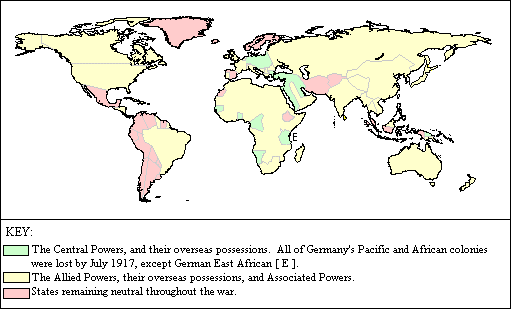When we met him last week on our way to the line.
Now the soldiers he smiled at are most of 'em dead,
And we're cursing his staff for incompetent swine.
'He's a cheery old card,' grunted Harry to Jack
As they slogged up to Arras with rifle and pack
But he did for them both by his plan of attack.
On the Western Front, the German Army's new Chief-of-Staff, General Erich von Ludendorff, is committed to defence. He pulls his forces back to a newly-constructed fortified frontline position, the Siegfried Line (known by the Allies as the Hindenburg Line). Ludendorff anticipates that the Siegfried Line will repulse Anglo-French attacks in the west, while he pursues victory on the Italian Front. On the Allied side, the French Army too has a new Commander-in-Chief, General Robert Nivelle, newly-promoted as a result of his role in the defence and counter-attack at Verdun. Nivelle intends to win a decisive victory on the Western Front by leading a coordinated infantry/artillery attack of the type which brought him success (albeit on a smaller scale) at Verdun. Using this strategy, Nivelle is openly confident that he can break through the German defences and win a conclusive victory in just 48 hours.
Nivelle's much-vaunted attack begins on 16 April 1917, when the French throw their entire strategic reserve of troops - 20 divisions in all, or 1.2 million men - onto the offensive on a 20 mile front between Soissons and Reims. The Germans, forewarned by Nivelle's confident predictions that an attack is imminent, are anticipating the offensive and are heavily reinforced. The advancing French infantry are decimated by massed machine-gun fire and, by the end of one week, an offensive which was confidently expected to advance 6 miles for minimal losses has advanced the frontline less than 600 yards and resulted in 100,000 French casualties. After entering the offensive with such high hopes of decisive victory, French morale begins to break in the face of such apparently pointless losses. From 17 April, "strikes" begin to break out among French units, and tens of thousands of men desert from the front. By the end of May, mutiny has spread to five towns behind the front line, where French soldiers throw down their weapons and refuse to go forward to fight. Nivelle is replaced as commander-in-chief by General Petain, who manages to contain the crisis by personally promising his troops that there will be no more costly offensives, and by improving leave and rest entitlements for frontline units. By the end of June, the mutiny has been quashed, but it has left the French Army capable of defensive operations only, and passes the burden of offensive activity in the west entirely to the British.
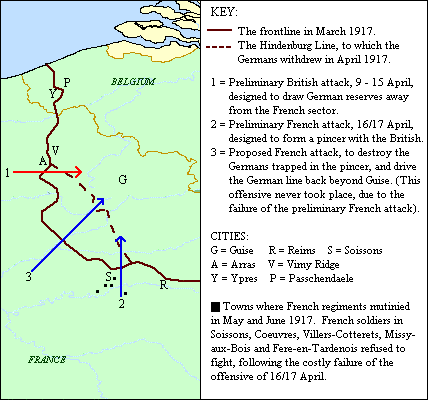
With the failure of the Nivelle offensive, British commander-in-chief Douglas Haig launches the main British attack of the year, in Flanders. After rapid preliminary successes at Messines Ridge and Wytschaete, the main offensive (The Third Battle of Ypres) begins on 31 July. The ambitious goal of the British Army at Third Ypres is to break through the German defences overlooking Ypres on the Passchendaele Ridge, creating a gap through which British cavalry will sweep all the way through to Bruges and the Channel port of Zeebrugge. In reality, the offensive advances painfully slowly, across a battlefield left waterlogged by torrential rain and prolonged artillery bombardment. Field-Marshall Haig modifies his objectives for the offensive: instead of being the decisive breakthrough on the Western Front, Third Ypres becomes a battle of attrition, where success is measured by the number of Germans killed rather than by the extent of the Allied advance.
By the beginning of November, the British have advanced their line forward five miles, a significant advance in terms of trench warfare, but a negligible achievement in view of the original objectives of the offensive. The battle finally ends on 6 November, when the Canadians capture of the offensive's opening objective of Passchendaele village, now just a "brick-coloured stain on a watery landscape". The cost of this gain is well over half a million casualties: comprising about 260,000 German, 8,500 French, and 300,000 British (including 40,000 unaccounted for, many presumed to have drowned in the mud).
Haig resolves to mount one further offensive in 1917, to preserve British morale and to win for the French Army more time to recover from the mutinies of the summer. On 20 November, he launches the first offensive by massed tank formations, against German positions around Cambrai. On this occasion, the attack takes the Germans completely by surprise. Within 10 hours the tanks have advanced five miles, and broken through the last significant line of German defences. However, the British have not anticipated an initial success on this scale, and have no reserves of men or tanks in the area to follow up on the long-awaited breakthrough. The German Second Army counter-attacks on 30 November, and by the time the Battle of Cambrai ends on 6 December it has retaken most of the land lost in the original attack, and the British have squandered their opportunity for a decisive victory.
Despite the scale of the Allied offensives (and losses) in the west, the truly momentous events of the year are not on the Western Front, but in the east. On 12 March, a shortage of bread leads to food riots in Petrograd, and that city's army garrison mutinies in support of the rioters. Tsar Nicholas II is forced to abdicate, and the Provisional (Menshevik) Government of Alexander Kerensky takes power. The minority (Bolshevik) opposition party in Petrograd demands an immediate end to the war, urging Russia's soldiers to bring about "Peace With Your Feet" (ie by deserting), but the Provisional government assures the Allies that Russia will continue to fight. The Germans see in the Bolshevik demand for immediate peace an opportunity to remove Russia from the war altogether. They grant the Bolsheviks' leader, Vladimir Lenin, safe passage back to Russia from his exile in Switzerland, in the hope that his promise of "Peace, Bread and Land" will finally break the Russian people's will to continue the war.
On 1 July 1917, the Russians launch offensives on the Austrian Front at Tarnopol, and to the north against the Germans around Vilnius. They meet with some success around Tarnopol, but when the Germans defeat the northern offensive and march on Riga, Russian Army discipline collapses. On 16 July, a Bolshevik uprising in Petrograd demands an immediate end to the war. When the government suppresses this uprising the next day, and orders the resumption of the Tarnopol offensive, thousands of troops on the Austrian Front throw down their weapons and flee the war zone. After the events of July 1917, Russia is effectively out of the war.
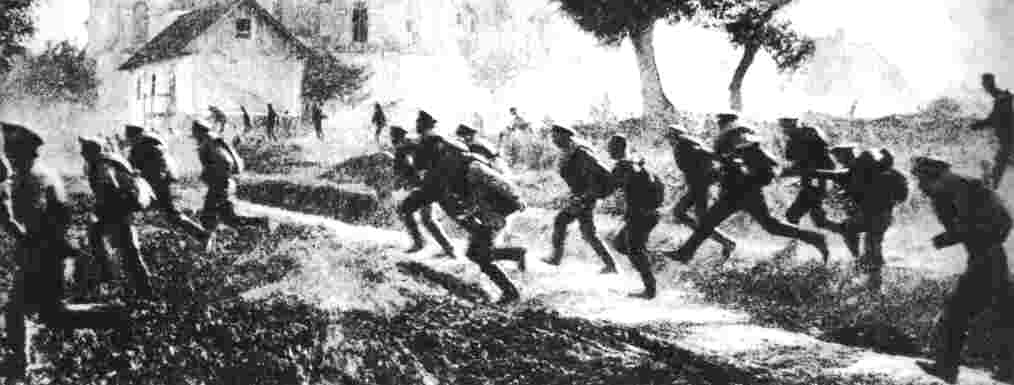
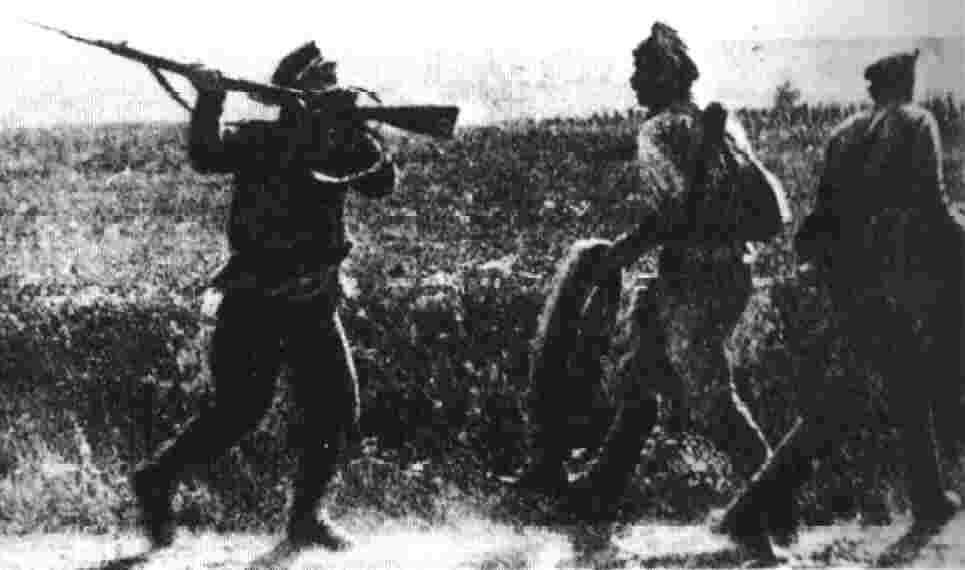
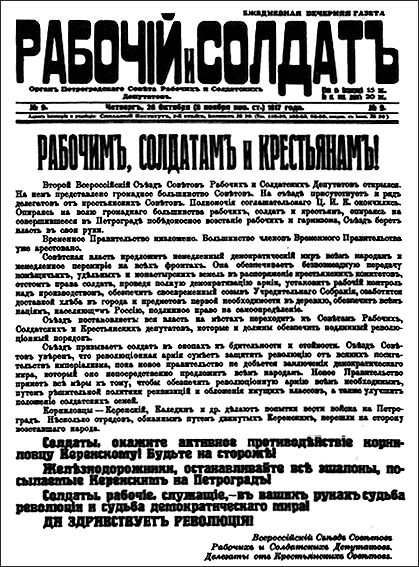
Above right - A Russian soldier forces two deserters back to the Austrian Front. Galicia, 1917.
Left - Lenin calls upon Russian soldiers to vote with their feet, in this 28 October 1917 edition of the Bolshevik newspaper "Worker & Soldier".
(Courtesy: The Marxists Internet Archive).
Railwaymen, hold up all troop trains dispatched by Kerensky...!
Soldiers, workers in factory and office, the fate of the revolution
and the fate of the democratic peace is in your hands!
Long live the revolution!"
On the home front, Germany too begins to show signs of war-weariness as social and industrial unrest arises during 1917. Although Germany was self-sufficient in food production before 1914, the loss of so many men to the Army makes the nation a net importer of food and vital materiel throughout the war. And, as the Royal Navy enjoys supremacy at sea, the Allies are able to blockade Germany, and prevent the import of food, with the result that the German government is forced to introduce increasingly severe food rationing.
Germany has one weapon capable of answering the Allied blockade, and that is her U-Boat Fleet. The German High Command believes that as Great Britain is an island, relying for its food and war materials on imports by sea, a complete blockade by the U-Boat fleet could starve Britain into submission within months. They hesitate to do it, because a complete blockade can only be brought about unrestricted submarine warfare, i.e. the sinking of not only Allied vessels, but of all nations' merchant ships sailing to or from Britain. Germany fears that by sinking neutral (specifically American) merchant vessels, she will force the United States into the war on the Allied side.
But on 31 January 1917, Germany opts anyway for unrestricted submarine warfare. She gambles that, once Britain is blockaded, the Allied cause will collapse within months; certainly well within the two-year period that it will take the United States to mobilise, train and transport an army in sufficient numbers to make a decisive difference on the Western Front. Through the spring of 1917, the sinking of neutral ships increases anti-German feeling worldwide; and one-by-one the affected neutral nations - initially, the United States, Brazil, Bolivia, Peru and China - sever relations with Germany. When the U.S. government learns from decoded German diplomatic traffic that Germany is negotiating an anti-American alliance with Mexico (and possibly Japan), the United States finally abandons neutrality and declares war on Germany on 6 April 1917.
